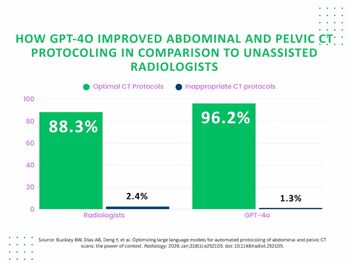
Toshiba Software Takes Aim at Nuclear Medicine Artifacts
Software Programs Improve Quantification As a mature modality, nuclear medicine has been forced to fendoff challenges from other technologies encroaching on its turf.The use of nuclear medicine in brain imaging, for example, hasplummeted since
Software Programs Improve Quantification
As a mature modality, nuclear medicine has been forced to fendoff challenges from other technologies encroaching on its turf.The use of nuclear medicine in brain imaging, for example, hasplummeted since CT and MRI were introduced in the mid-1970s andearly 1980s. To stay competitive, nuclear medicine must focuson acquiring quantitative measurements, said Steve Sickels, managerof nuclear medicine for Toshiba America Medical Systems of Tustin,CA.
At this month's Society of Nuclear Medicine meeting, Toshibaplans to showcase a package of software enhancements designedto improve the ability of Toshiba gamma cameras to provide quantitativestudies.
"We need to become a quantitative modality, in cardiacspecifically," Sickels told SCAN. "If we want to beviable and competitive we need to quantitate a lot more."
Quantitative studies are important because they are objectiveand reproducible -- both vital requirements for applications suchas staging pathology, Sickels said.
"When (a patient) comes in on Tuesday and then comes inon Tuesday a week later you will see the same thing (with a quantitativestudy)," Sickels said.
Toshiba's quantitation package features three components:
** Triple-energy window (TEW), a technique that compensatesfor Compton x-ray scatter;
** Transmission/emission imaging with an external radiationsource to correct attenuation artifacts; and
** Motion correction techniques to compensate for motion artifacts.
The package is being developed for Toshiba's dual- and triple-headgamma cameras and will be shown as a works-in-progress at theSNM meeting, Sickels said.
The package is a reflection that nuclear medicine is becomingmore software-driven, he said.
"Our basic message is improved image quality with softwareenhancements," Sickels said.
Agfa names new technical imaging chiefFilm and PACS vendor Agfalast week announced that Caren Mason will become head of the company'stechnical imaging systems division, which includes medical, technicaland industrial diagnostic products. Mason will succeed John McGlynn,who plans to retire in 1995.
Mason's prior position at Agfa was vice president of marketingand business development for diagnostic imaging systems. She joinedAgfa, of Ridgefield Park, NJ, in 1989. Mason's appointment iseffective July 1.
HIS vendor HBO & Co. buys IBAXHospital and radiology informationsystems vendor HBO & Co. will acquire IBAX, the IBM/BaxterHealthcare joint venture that also markets HIS and RIS products.
IBAX was formed in 1989 when IBM and Baxter joined forces (SCAN10/11/89). The company offers HIS products running on IBM mainframesand minicomputers. There are 475 IBAX systems installed nationwide.
Atlanta-based HBO will continue to offer IBAX products afterthe merger, according to HBO president and CEO Charles McCall.HBO plans to build interfaces between its products and those ofIBAX, McCall said.
The deal is expected to close this month, McCall said.
Newsletter
Stay at the forefront of radiology with the Diagnostic Imaging newsletter, delivering the latest news, clinical insights, and imaging advancements for today’s radiologists.




























